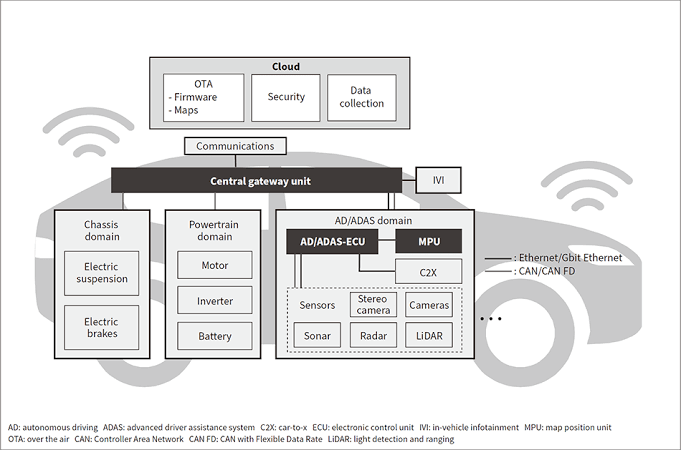The world is at the corner of a transportation revolution, and at the heart of it lies the remarkable concept of 5G self-driving cars. These futuristic vehicles are not just a technological marvel; they are set to reshape the foundations of urban planning as we know it. In this blog, we will explore the fascinating world of 5G self-driving cars, their global development, and their profound implications for urban planning.
Self-Driving Cars: A Glimpse into the Future
Self-driving cars, also known as autonomous vehicles, represent the pinnacle of automotive innovation. These vehicles are equipped with cutting-edge technology that allows them to navigate and make decisions without human intervention. They rely on combination of sensors, cameras, radar, lidar, and artificial intelligence to perceive their surroundings and drive safely.
The development of self-driving cars has been accelerating worldwide. As of our latest data in 2022 The projected value of the self-driving car market by 2030 is $536.6 billion. It is anticipated that by 2040, approximately 70% of new vehicles will feature some level of automation, and by 2045, an estimated 60% of vehicles will have achieved full autonomy. The implementation of self-driving technology also has the potential to result in a substantial 90% reduction in emissions related to traffic and a noteworthy enhancement in fuel efficiency, with gains ranging from 10% to 20%.
Around the globe, autonomous vehicle initiatives and pilot programs have been gaining traction. From Europe to Asia, governments and companies are pushing the boundaries of what’s possible in the realm of self-driving technology. This concerted global effort highlights the significance of autonomous vehicles in the future of transportation.
Urban Planning Latest News/Updates from India & USA
India:
India has started on a journey to modernize its urban landscape through initiatives like the Smart Cities Mission. The incorporation of self-driving cars into this framework could potentially revolutionize urban mobility. Recently, Indian cities have shown growing interest in embracing autonomous vehicles to enhance transportation efficiency, reduce congestion, and improve air quality.
USA:
In the USA, cities like San Francisco and Phoenix have emerged as hubs for testing and piloting autonomous vehicles. The nation has been keen on adopting new transportation technologies to address traffic congestion, reduce accidents, and create more sustainable urban environments. Federal and state governments have also been working on regulatory frameworks to facilitate the integration of self-driving cars.
an outline diagram of the car’s architecture, depicting the array of sensors and technologies that enable it to operate autonomously.
In the next sections of this blog, we will delve deeper into the potential benefits and challenges of integrating 5G self-driving cars into urban planning, as well as the pivotal role of urban planners in shaping this exciting future. Stay tuned for a closer look at how self-driving cars could transform our cities.
Benefits of 5G Self-Driving Cars for Urban Planning
1.Reducing Traffic Congestion
Imagine a world where self-driving cars seamlessly communicate with each other, forming a symphony of synchronized movement on our streets. This orchestrated flow can significantly reduce traffic jams, making your daily commute not just faster but stress-free, and it can also lead to considerable fuel savings and emissions reduction.
2. Increased Road Safety
One of the most compelling aspects of self-driving cars is their unwavering focus and unyielding adherence to traffic laws. Unlike human drivers, these autonomous vehicles do not get distracted, fatigued, or engage in risky behaviors. This means fewer accidents, fewer injuries, and safer streets for everyone, offering a reassuring sense of security to pedestrians and passengers alike.
3. Improved Air Quality
Less traffic congestion and more efficient driving by self-driving cars equate to fewer idling vehicles emitting pollutants. The result is a significant improvement in air quality, which can contribute to a healthier environment and reduced health-related issues in urban areas. Cleaner air can lead to better overall public health outcomes, making cities more livable.
4. Increased Accessibility for People with Disabilities
For people with disabilities, self-driving cars represent a breakthrough in mobility. These vehicles can offer newfound freedom and independence, enabling individuals with mobility challenges to access employment, education, and recreational activities more easily. The removal of traditional transportation barriers is a monumental step toward greater inclusivity in our cities, enhancing the quality of life for all residents.
Challenges of Integrating 5G Self-Driving Cars into Urban Planning
1.Redesign of Streets and Sidewalks
Embracing self-driving cars means rethinking the layout of our streets and sidewalks. Urban planners will need to consider how these vehicles interact with the urban environment and may need to redesign road infrastructure to accommodate their specific needs. This could include dedicated lanes or specialized intersections for autonomous vehicles.
2. Allocation of Scarce Parking Spaces
While self-driving cars might ultimately lead to fewer vehicles on the road, they will still require parking spaces when not in use. Urban planners will need to address the allocation and management of these spaces efficiently, potentially repurposing underutilized areas and reevaluating parking policies to optimize land use.
3. Regulation of Self-Driving Car Technology
Developing robust safety standards and regulations for self-driving car technology is paramount. Urban planners and policymakers will play a pivotal role in crafting and enforcing rules that ensure these vehicles operate smoothly and securely within city limits. This includes addressing issues related to liability, insurance, and data privacy.
4. Cybersecurity Concerns
As self-driving cars become more connected and reliant on data, the risk of cybersecurity threats increases. Urban planners and city authorities will need to collaborate closely with technology experts to establish robust cybersecurity measures to protect against potential hacking and data breaches, ensuring the safety and privacy of citizens.
The Role of Urban Planners in Shaping the Future of 5G Self-Driving Cars
1. Working with Transportation Engineers and Stakeholders
Effective collaboration with transportation engineers, technology companies, law enforcement, and community stakeholders is essential. Urban planners must foster cooperation among these groups to develop holistic strategies that integrate self-driving cars seamlessly into the urban fabric.
2. Developing New Policies and Regulations
Urban planners will need to take the lead in developing innovative policies and regulations that govern the use of self-driving cars. These regulations should strike a balance between promoting innovation and ensuring public safety, addressing issues like licensing, testing, and liability.
3. Investing in Infrastructure
To support the widespread adoption of self-driving cars, cities must invest in modern infrastructure. This includes building and maintaining advanced road networks, ensuring reliable 5G connectivity, and establishing charging or refueling infrastructure for autonomous vehicles, all of which will require substantial financial commitment and long-term planning.
4. Educating the Public
Lastly, urban planners have a responsibility to educate the public about the advantages and challenges of self-driving cars. Through informative campaigns and community engagement, planners can build public trust and acceptance of this transformative technology, ensuring that citizens are informed and ready to embrace the future of transportation.
Conclusion
The era of 5G self-driving cars is on the horizon, and it promises a brighter, more efficient future for urban planning. While challenges lie ahead, with collaboration and careful planning, our cities can harness the potential of this transformative technology for the benefit of all. Get ready to sit back, relax, and let the cars do the driving!






